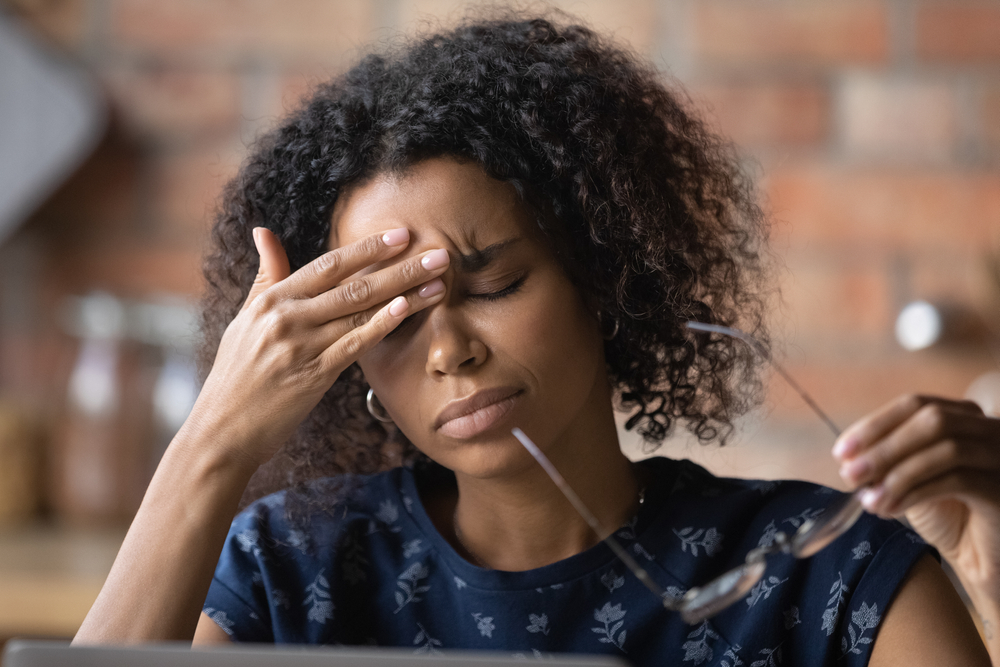Discover how targeting specific body locations can provide fast headache relief without medication
When a headache strikes, the instinct to reach for pain medication is almost automatic. Yet long before modern pharmaceuticals, people across cultures relied on an approach that required nothing more than their own hands: acupressure. This ancient practice targets specific points on the body to relieve pain and restore balance, often providing surprisingly fast relief.
“I was skeptical at first, but pressing these points during a migraine actually helped reduce my pain significantly,” shares a 34-year-old teacher from Boston. “Now it’s my first line of defense before taking any medication.”
For the 47% of adults worldwide who experience headaches regularly, these natural techniques offer a complementary approach that can be used anywhere, anytime—whether you’re sitting at your desk, traveling, or lying in bed.
How pressure points actually work against headaches
Acupressure operates on principles similar to acupuncture but uses finger pressure instead of needles. The technique works through several physiological mechanisms that modern science is beginning to understand.
Stimulating pressure points triggers the release of endorphins—the body’s natural painkillers—which can help reduce headache pain rapidly. The pressure also promotes improved blood circulation to tight, contracted areas that may be contributing to head pain, especially for tension headaches that stem from neck and shoulder tightness.
Additionally, activating these points helps regulate the autonomic nervous system, potentially shifting the body from “fight or flight” stress mode to “rest and digest” relaxation mode. This transition can be particularly beneficial for stress-induced headaches.
While not a replacement for medical care for severe or chronic headaches, pressure point therapy offers a risk-free option to try before—or alongside—conventional treatments. The technique works best when applied at the first sign of discomfort rather than waiting until pain becomes severe.
The union valley point for fast relief
Located between the thumb and index finger, this powerful pressure point (LI4) has been used for centuries to address head pain. Known as “Hegu” in traditional Chinese medicine, this spot creates a strong analgesic effect when properly stimulated.
To find this point, bring your thumb and index finger together, then locate the highest point of the muscle that forms at the base of the thumb. When you spread your fingers, you’ll notice a web-like area—the pressure point sits at the highest mound of this muscle.
To activate it, use the thumb and index finger of your opposite hand to pinch this area firmly. Apply steady, strong pressure for 4-5 minutes while taking slow, deep breaths. The sensation should be intense but not painful—aim for what practitioners describe as “comfortable discomfort.”
For best results, work both hands simultaneously or alternately. Many people report feeling relief spread from their hands up to their head within minutes of applying pressure. This point proves particularly effective for frontal headaches and pain concentrated around the eyes or forehead.
Note that pregnant women should avoid stimulating this point, as it can potentially stimulate uterine contractions—a precaution widely recognized in acupressure practice.
The third eye point for sinus and frontal headaches
Situated between the eyebrows where the bridge of the nose meets the forehead, this point (known as Yintang or GV24.5) helps relieve frontal headaches and sinus pressure. The location corresponds to the third eye in many spiritual traditions and serves as a powerful relaxation trigger.
To stimulate this area, use your index finger or thumb to apply firm, gentle pressure directly between your eyebrows. Make small, circular motions while maintaining steady pressure for about one minute. Some practitioners recommend closing your eyes during this technique to enhance the relaxation response.
This point works exceptionally well for sinus-related headaches, especially when combined with gentle massage along the eyebrows and down the sides of the nose. The pressure helps drain congested sinuses while relaxing the frontal area of the head where tension often accumulates.
Many people find this technique particularly soothing before bed, as it promotes overall relaxation beyond just headache relief. Regular stimulation of this point may help prevent stress-related headaches by reducing accumulated tension in the facial muscles.
The gates of consciousness for migraine relief
Located at the base of the skull in the hollow areas between the two vertical neck muscles (about two inches apart), these paired points (GB20) can provide significant relief for migraines and headaches that originate from neck tension.
To find these points, interlace your fingers behind your head, then use your thumbs to press into the depressions at the base of your skull, just below the bony ridge. These spots often feel tender when pressed, indicating accumulated tension in the area.
Apply firm pressure upward (toward the ceiling) rather than straight into the skull. Maintain the pressure for 1-2 minutes while taking deep breaths. Some people prefer to lie down while performing this technique, with a small, firm ball placed between the points and a hard surface.
These points effectively address headaches that involve the back of the head and neck, including those triggered by poor posture or long periods of computer work. Regular stimulation of this area can help prevent tension from building up along the cervical spine that often leads to headaches.
For enhanced results, combine this technique with gentle neck stretches, rotating the head slowly in each direction after releasing the pressure points.
The shoulder well point for tension headaches
Positioned at the highest point of the shoulder muscle (trapezius), halfway between the shoulder joint and the base of the neck, this point (GB21) directly addresses tension headaches stemming from shoulder and upper back tightness.
Locate this point by dropping your hand to your side, then bringing it diagonally across your chest to the opposite shoulder. The highest point your fingers naturally reach marks the approximate location of the shoulder well point.
Using the thumb and index finger of the opposite hand, grasp this muscle area firmly and knead it with moderate pressure. You can also use knuckles to apply downward pressure if reaching across is difficult. Many people find this area particularly sensitive, so adjust pressure accordingly.
This technique works best when applied for 1-2 minutes on each side, focusing on slow, steady pressure rather than rapid movements. The relief often radiates from the shoulders up into the neck and head as tension releases.
For office workers and those who spend long hours at computers, stimulating this point several times throughout the day can prevent the muscle tension that frequently leads to end-of-day headaches.
The temple region for comprehensive relief
The temples—the flat areas on either side of the forehead—contain several pressure points that can help relieve various types of headaches, particularly those involving throbbing pain or eye strain.
To access these points (known as TE23, GB1, and others in the temple region), use your index and middle fingers to apply gentle, circular pressure to the temple areas. Start with light pressure and gradually increase to a comfortable level, as this area can be sensitive.
For enhanced results, try “combing” the temples by using fingertips to apply pressure while slowly drawing them upward from the outer edge of the eyebrow toward the hairline. Repeat this motion 10-15 times on each side.
This technique proves particularly effective for headaches associated with eye strain, stress, or excessive screen time. Many people find that combining temple pressure with gentle massage of the entire scalp creates more comprehensive relief.
For migraine sufferers, cooling the temples while applying pressure—using a cold compress or even cold spoons—can enhance the pain-relieving effects by constricting blood vessels that may be dilated during migraine attacks.
The drilling bamboo points for eye-related headaches
Located in the indentations at the inner corners of the eyebrows, near the bridge of the nose, these paired points (known as BL2) target headaches connected to eye strain, sinus pressure, or allergies.
To stimulate these points, use your index fingers to apply firm pressure to both sides simultaneously. Press upward and inward toward the brow bone for 1-2 minutes while maintaining slow, deep breathing.
Some people prefer to use their thumbs placed under the brow ridge, applying upward pressure into the same points from below. Either approach effectively targets the area where the frontal and periorbital regions connect.
This technique offers particular benefits for headaches triggered by lengthy reading sessions, computer work, or other visually demanding tasks. Regular stimulation throughout periods of intense focus can prevent headaches before they develop.
For enhanced effects, combine this technique with brief eye exercises, such as looking into the distance for 20 seconds after 20 minutes of close-up work—a practice known as the “20-20-20 rule” among vision specialists.
The foot reflexology point for whole-body balance
While seemingly distant from the head, a specific point on the foot connects directly to headache relief through reflexology principles. This point is located in the webbing between the big toe and second toe, about one-third of the way up from the base of the toes.
To activate this powerful spot (similar to the hand’s LI4 point), use your thumb and index finger to pinch and firmly massage this area for 2-3 minutes per foot. The pressure should feel strong but tolerable, creating a sensation that may radiate up the foot.
This technique works through the body’s fascial and meridian connections, potentially triggering release in the neck and head regions despite the distance between these areas. Many people report feeling a pleasant warmth spreading through their body when this point is correctly stimulated.
For comprehensive relief, try alternating between foot and hand points during the same session. This combined approach addresses the body’s pain pathways through multiple entry points, potentially creating more significant relief than either technique alone.
As with other pressure points, consistency matters—regular stimulation may help prevent headaches from developing as readily over time.
Maximizing pressure point effectiveness
To get the most benefit from acupressure for headaches, several factors can enhance results:
Proper technique matters more than force. Apply firm, steady pressure rather than overly aggressive pushing that might cause bruising or discomfort. The sensation should feel like “comfortable discomfort”—intense but not painful.
Timing significantly impacts effectiveness. Applying pressure at the first sign of headache often yields better results than waiting until pain becomes severe. For chronic headache sufferers, regular preventive sessions (even when pain-free) may reduce frequency and intensity of episodes.
Breathing deeply while stimulating pressure points enhances their effectiveness by promoting relaxation and increasing oxygen flow throughout the body. Aim for slow belly breaths rather than shallow chest breathing.
Consistency creates cumulative benefits. While immediate relief is possible, the most significant improvements often come from regular practice over time, as the body becomes more responsive to these techniques.
Combining points often works better than focusing on just one area. Creating a personal routine that addresses several points in sequence can provide more comprehensive relief, especially for complex headaches with multiple triggers.
While acupressure offers a valuable tool for headache management, it works best as part of a holistic approach. Stay hydrated, manage stress, maintain regular sleep patterns, and address any underlying health issues to maximize these natural techniques’ effectiveness.
For those experiencing severe, chronic, or suddenly different headache patterns, these techniques should complement rather than replace medical evaluation. Certain headaches may signal serious conditions requiring immediate medical attention.
The beauty of pressure point therapy lies in its accessibility—these techniques require no special equipment and can be discreetly performed almost anywhere. Whether you’re facing an occasional tension headache or managing chronic pain, these ancient methods offer a remarkably modern solution: drug-free relief literally at your fingertips.













